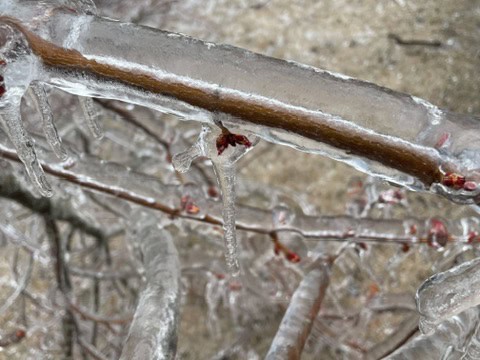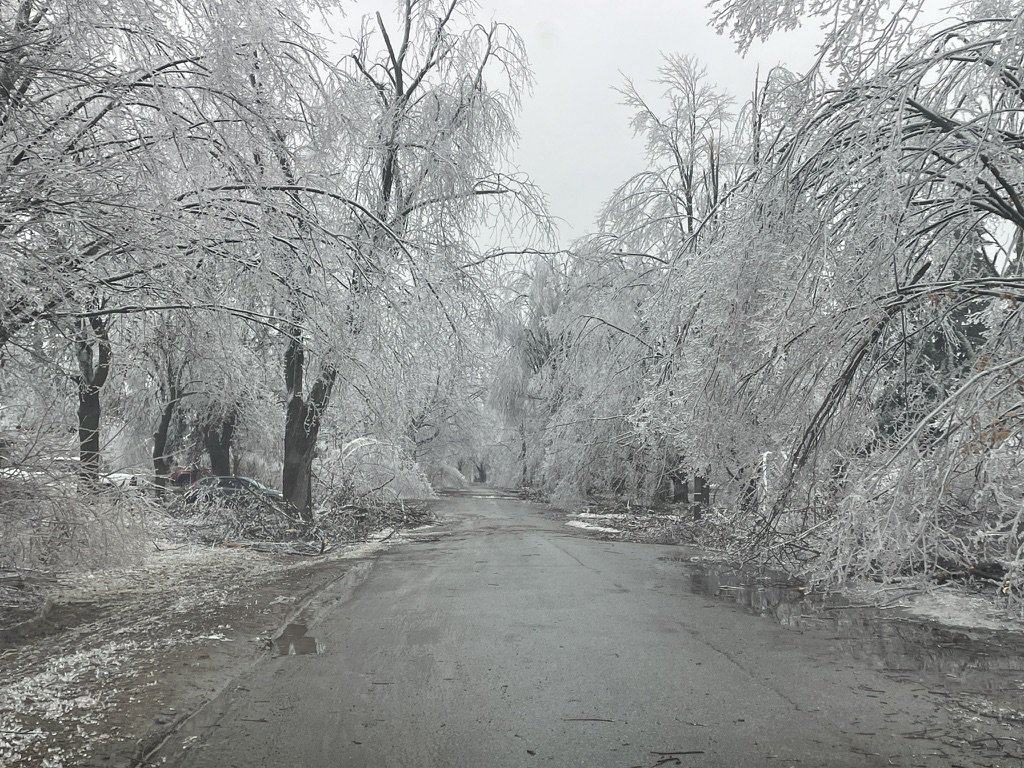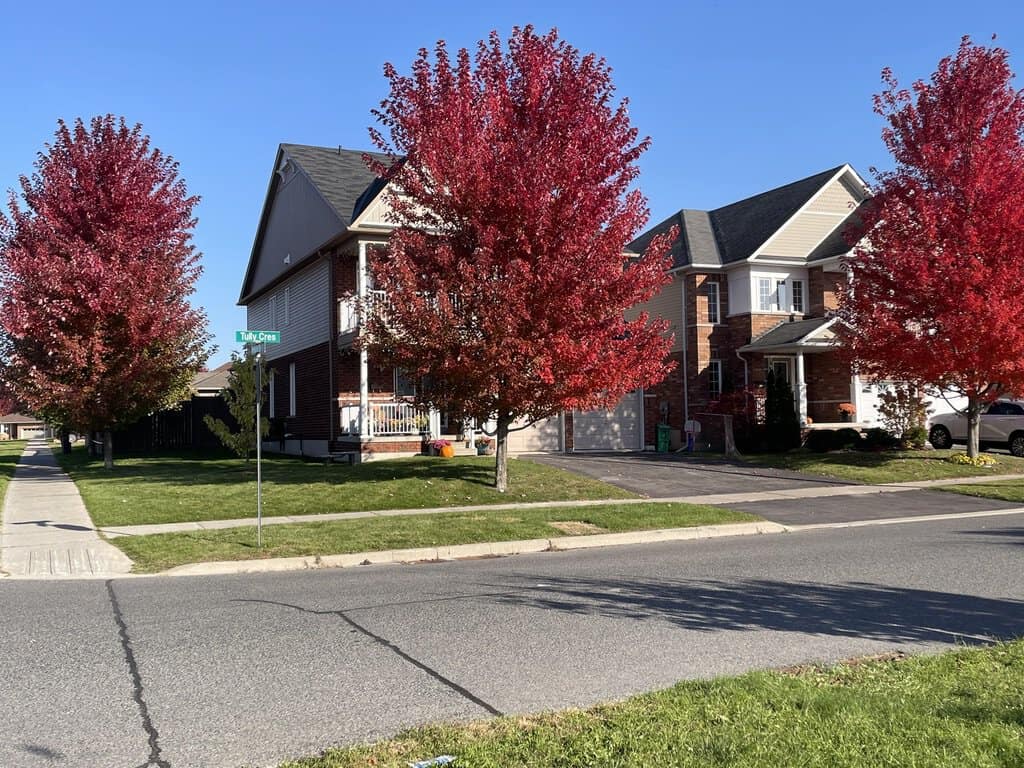Replanting is more important than ever – both for nature and for us
Peterborough Examiner – April 11, 2025 – by Drew Monkman
The recent ice storm that swept through central Ontario has left a trail of devastation in its wake. While power lines, homes, and vehicles suffered significant damage, the most severe and widespread impact has been to the region’s trees. Tragically, one individual also lost his life near Peterborough due to a falling tree.
The amount of tree damage appears to have surpassed that of the derecho storm of May 2022. The destruction in some parts of Peterborough is staggering, not only evident in the huge piles of roadside brush but also in the shredded and misshapen canopies of countless trees.

In rural areas, all of the Kawartha Land Trust properties were also battered. Early reports point to devastation equal to or worse than that of three years ago. East of Peterborough, Warsaw area resident, Tim Dyson, reports that “Some red pine plantations suffered catastrophic losses, especially those that were hit hard by the derecho. In one five-acre plantation, 90% of the trees have been lost.” Dyson also said that a great blue heron colony in a red maple swamp near his home was completely wiped out. Almost two weeks later, however, most of the adults are still in attendance and loaf about on the battered canopy which once held their nests. He also witnessed the destruction of raven nests with young. It’s likely that the chicks of other early nesting species like great horned owls will have also perished.
It’s very difficult to look at the destruction without feeling grief and a deep sense of loss. For so many of us, trees are not simply part of the scenery; they’re woven into our sense of place, memory, and even emotional stability. I have a host of memories connected to all of the trees on our property, all of which I planted myself. Seeing at least four mature trees nearly destroyed in a matter of hours is heartbreaking. It feels like losing a part of our home, even if the house itself was unscathed.
Sudden loss of trees can also trigger stress and anxiety, especially after repeated calamities like the derecho, the ice storm and, of course, the devastating impact of the emerald ash borer. There’s a real sadness in seeing such severely altered landscapes. Your backyard, street or local park simply doesn’t feel the same. It’s almost disorienting.
Trees provide beauty, a welcome shelter from the sun, and a sense of calm. They also represent continuity through the years while so much else in our lives is changing. Losing the sheltering tree canopy makes you feel more exposed, not only physically but even emotionally. For urban dwellers, backyard and neighbourhood trees are also one of the few connections to the natural world. With their loss, there’s a parallel loss of the many birds and other creatures that they attract. No longer having a feeding, roosting or nesting site, they are seen less frequently. This, too, is painful.

Vulnerability by species
Tree resilience to ice storms varies greatly depending on species. Because of differences in structure, wood strength, and growth habits, some trees are much better than others at withstanding the weight of ice.
Trees that are often most susceptible to damage tend to have wide, spreading crowns that collect a lot of ice. Many of these are fast-growing species which often means weaker, more brittle wood. They include trees like silver maple, Freeman’s maple (a red/silver maple cross), Norway maples, poplars, aspens, and birches. Although the latter three bend easily under ice and can sometimes bounce back upright, they often snap if overloaded. This is especially so for older trees. Mature white pines growing in the open are also vulnerable, since they develop multiple leader trunks which catch more ice and wind. Young pines fare much better as do young trees of almost all species.
Trees that are more resilient to freezing rain tend to have dense wood, flexible branches, wide branch angles from the trunk, and a dominant central trunk as opposed to multiple, competing leaders. A dominant trunk can be developed by proper pruning when the trees are young. Among the most resilient species are basswoods, sugar maple, oaks, hickories, ironwoods (Ostrya), black willow, hemlocks and spruces. Spruce branches tend to point downwards and the branches are very flexible.
Even for trees that appear heavily damaged, this is not necessarily a death sentence. According to Shaun Watmough, professor and director of Trent University’s School of the Environment, “It’s fairly remarkable. If you have less than 50 per cent of crown damage, a lot of the trees can bounce back.” In an interview with The Examiner (April 5, 2025), he also said that studies done after the 1998 ice storm showed that only about two percent of the trees in forest stands actually died.

Going forward
The worst reaction to the ice storm would be to simply decide against planting trees ever again. I hope this doesn’t happen. Through replanting, we can find healing, resilience and renewal. It’s no less than a way of reclaiming space and fighting back against the onslaught of threats to nature. Trees are essential for other species to thrive and for humans to feel a connection to the natural world.
It’s now abundantly clear in central Ontario – and most everywhere else – that we’re seeing the repeated and ever-worsening effects of climate change-related extreme weather. At the same time, we’re in the midst of a biodiversity crisis, with everything from birds and mammals to amphibians and insects suffering huge losses in their populations.
With both these crises in mind, what should property owners be planting? Here’s a quick list of some of my favourite climate-adapted, storm-hardy, and bird- and pollinator-friendly trees and shrubs that will hold up well both in urban and rural settings.
Deciduous trees and shrubs: American basswood; little-leaf linden; bur, white and red oaks; hackberry; bitternut hickory; honey locust; red maple; autumn blaze maple (with proper pruning), Kentucky coffeetree; downy serviceberry; choke and pin cherry; crab-apple; ninebark; red-osier and alternate-leaf dogwood; hawthorns; staghorn sumac; common and red-berried elder; nannyberry; hobblebush; and pussy willows. Oaks, willows and cherries host the most caterpillars of any tree genus, which makes them extremely attractive to hungry birds.
Conifers: White pine; eastern hemlock; eastern white cedar; white and blue spruce; and eastern red cedar, a type of juniper. Conifers like eastern white cedars and both blue and white spruce also offer excellent cover for birds.
When planting, think thickets (e.g., 3-4 trees underplanted with 4-6 shrubs); think hedgerows (e.g., a mix of shrubs and conifers); think snags (e.g., where safe, leave a standing dead tree); think dual purpose (i.e., species that offer both food and cover); and think site conditions (i.e., Is the site dry or damp? Sunny or shady?). It’s also important to have an experienced arborist come by every couple of years to check whether your trees need pruning. Pruning will assure far better resistance to future storms of all kinds.

Ice storms and climate change
Although climate change has not yet been shown to directly “cause” ice storms, global heating definitely raises the odds of the kind of conditions that make these storms more likely: warmer winters, more atmospheric moisture, and erratic weather patterns.
As the climate warms, average winter temperatures are rising faster than any other season. Even this past winter, only February was colder than usual. This means that more precipitation may fall as rain instead of snow. When that rain hits cold surfaces or falls through a shallow layer of freezing air, it can turn into freezing rain. A warmer atmosphere also carries more moisture. So, when conditions are right, this leads to heavier ice accumulation. Climate change is also affecting the Jet Stream and storm tracks leading to changes in where and how often ice storms form.